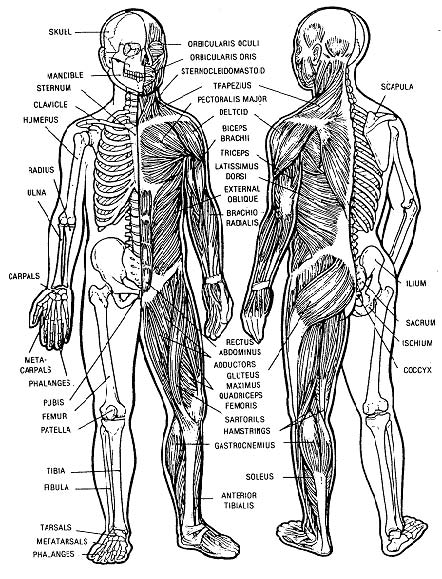1-1. THE MUSCULOSKELETAL SYSTEM
a. The musculoskeletal system is composed of bones, joints, muscles, cartilage, ligaments, and tendons. The skeleton provides a structural framework for the body and, because bones are rigid, provides support and protection for vital organs and softer tissues. Skeletal muscles and bones work together to make body movement possible. Blood cell formation (called hematopoiesis) occurs in bone marrow, and bones store minerals such as calcium and phosphorus.
b. Orthopedics is the branch of medicine and surgery that is concerned with the preservation and restoration of the function of the skeletal system, its articulations (joints), and its associated structures by medical, surgical, and physical means.
c. Refer to figure 1-1 to refresh your knowledge of the names and locations of the major muscles and bones.

1-2. ORTHOPEDIC NURSING
a. The challenge in caring for the orthopedic patient is in carrying out basic nursing care procedures while understanding and working with orthopedic devices used in the treatment of musculoskeletal diseases and injuries. To avoid self-injury, those engaged in orthopedic nursing must also understand and apply principles of good body mechanics.
b. Many orthopedic patients are immobilized by casts, traction, or other means for long periods of time. Orthopedic nursing includes maintaining muscle tone and circulation to prevent contractures, deformity, and pressure sores by frequently changing the position of immobilized patients.
c. Often confined to bed and in many cases immobile, the orthopedic patient may require a great deal of assistance with daily living activities. His bedding should be kept clean, dry, and wrinkle free. Because he is susceptible to skin breakdown and pressure sores, he should be assisted and encouraged to change positions within the limits prescribed by the physician. He should be encouraged to be as independent as possible within the limits of his immobility and personal hygiene should be emphasized.
d. Immobility, fear of deformity, and a potentially long hospitalization may cause the patient to become depressed or discouraged. The understanding and encouragement of nursing personnel can increase morale.
Encourage self-reliance, but give help willingly and cheerfully when the patient needs assistance. Continuous teaching will help the patient understand his condition and his limitations and enable him to become more independent as his condition improves and he is rehabilitated.
